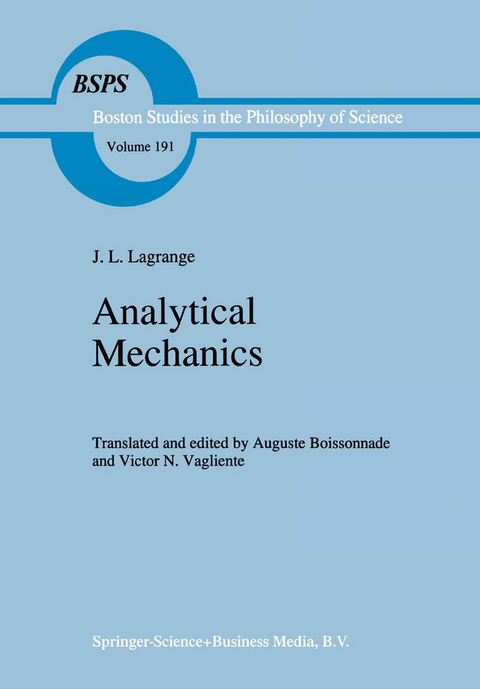
Analytical Mechanics
Springer (Verlag)
978-90-481-4779-3 (ISBN)
The analytical style that characterizes the Mecanique Analytique was evident in La- grange's original derivation in 1755 of the 8-algorithm in the calculus of variations. It was expressed in his consistent attempts during the 1770s to prove theorems of mathematics and mechanics that had previously been obtained synthetically. The scope and distinctiveness of his 1788 treatise are evident if one compares it with an earlier work of similar outlook, Euler's Mechanica sive Motus Scientia Analyt- 1 ice Exposita of 1736.
Section I — The Various Principles of Statics.- Section II — A General Formula of Statics and its Application to the Equilibrium of an Arbitrary System of Forces.- Section III — The General Properties of Equilibrium of a System of Bodies Deduced from the Preceding Formula.- Section IV. A More General and Simpler Way to Use the Formula of Equilibrium Presented in Section II.- Section V — The Solution of Various Problems of Statics.- Section VI. The Principles of Hydrostatics.- Section VII. The Equilibrium of Incompressible Fluids.- Section VIII. The Equilibrium of Compressible and Elastic Fluids.- Section I. The Various Principles of Dynamics.- Section II. A General Formula of Dynamics for the Motion of a System of Bodies Moved by Arbitrary Forces.- Section III. General Properties of Motion Deduced from the Preceding Formula.- Section IV. Differential Equations for the Solution of All Problems of Dynamics.- Section V. A General Method of Approximation for the Problems of Dynamics Based on the Variation of Arbitrary Constants.- Section VI. The Very Small Oscillations of an Arbitrary System of Bodies.- Section VII. The Motion of a System of Free Bodies Treated as Mass Points and Acted Upon by Forces of Attraction.- Section VIII. The Motion of Constrained Bodies Which Interact in an Arbitrary Fashion.- Section IX. Rotational Motion.- Section X. The Principles of Hydrodynamics.- Section XI. The Motion of Incompressible Fluids.- Section XII. The Motion of Compressible And Elastic Fluids.
| Erscheint lt. Verlag | 3.12.2010 |
|---|---|
| Reihe/Serie | Boston Studies in the Philosophy of Science ; 191 |
| Übersetzer | A. Boissonnade, V.N. Vagliente |
| Zusatzinfo | XLV, 594 p. |
| Verlagsort | Dordrecht |
| Sprache | englisch |
| Maße | 160 x 240 mm |
| Themenwelt | Geisteswissenschaften ► Geschichte |
| Mathematik / Informatik ► Mathematik ► Geschichte der Mathematik | |
| Naturwissenschaften ► Physik / Astronomie ► Allgemeines / Lexika | |
| Naturwissenschaften ► Physik / Astronomie ► Mechanik | |
| ISBN-10 | 90-481-4779-4 / 9048147794 |
| ISBN-13 | 978-90-481-4779-3 / 9789048147793 |
| Zustand | Neuware |
| Haben Sie eine Frage zum Produkt? |
aus dem Bereich


